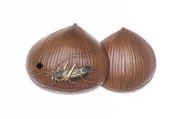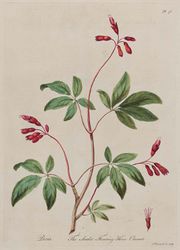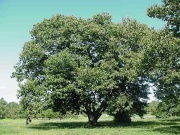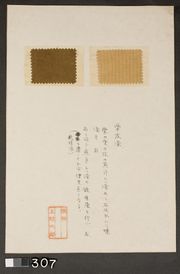Difference between revisions of "Chestnut"
| Line 9: | Line 9: | ||
American chestnut (''Castanea dentata''); European chestnut (''Castanea sativa''); Chinese chestnut (''Castanea mollissma''); Kastanje (Dan., Ned.); Edelkastanie (Deut.); castaño (Esp.); châtaignier (Fr.); Kasztan (Pol.); castagno (It.) | American chestnut (''Castanea dentata''); European chestnut (''Castanea sativa''); Chinese chestnut (''Castanea mollissma''); Kastanje (Dan., Ned.); Edelkastanie (Deut.); castaño (Esp.); châtaignier (Fr.); Kasztan (Pol.); castagno (It.) | ||
| − | Note: not the same as horse | + | Note: not the same as [[Horse chestnut|horse chestnut]], water chestnut or chestnut oak. |
== Collection Risks == | == Collection Risks == | ||
| Line 18: | Line 18: | ||
== Physical and Chemical Properties == | == Physical and Chemical Properties == | ||
| − | Large tree growing over 30 m. Bark=smooth dark brown Leaves=simple, ovate with veins and serrated edges. | + | * Large tree growing over 30 m. |
| + | * Bark=smooth dark brown | ||
| + | * Leaves=simple, ovate with veins and serrated edges. | ||
| + | * Flowers=tan (male) or tiny pale green (female) catkins (8-10 cm long). | ||
| + | * Fruit=Large husk containing 2-3 shiny brown nuts. | ||
| + | * Soft, lightweight wood with porous rings (specific gravity= 0.48; density= 36-46 ppcf). | ||
| + | * Wood is low in salts and high in acids. | ||
| − | |||
| − | |||
| − | |||
== Working Properties == | == Working Properties == | ||
Chestnut wood has excellent outdoor resistant. The light brown color is often mistaken for oak, but the timber from old trees is neither as hard or strong as oak. It can split and warp when harvested. Chestnut is rarely found in building structures, but rather as small pieces such as barrels, stakes and fencing. | Chestnut wood has excellent outdoor resistant. The light brown color is often mistaken for oak, but the timber from old trees is neither as hard or strong as oak. It can split and warp when harvested. Chestnut is rarely found in building structures, but rather as small pieces such as barrels, stakes and fencing. | ||
| + | |||
== Additional Images == | == Additional Images == | ||
<gallery> | <gallery> | ||
File:30_Chestnut.jpg|thumb|Chestnut (''Castanea dentata'') | File:30_Chestnut.jpg|thumb|Chestnut (''Castanea dentata'') | ||
| − | File:24_Am. Chestnut_100x_Rad.jpg|thumb|American chestnut (''Castanea dentata'') | + | File:24_Am. Chestnut_100x_Rad.jpg|thumb|American chestnut (''Castanea dentata'')<br> radial section at 100x |
| − | File:24_Am. Chestnut_100x_Tan.jpg|American chestnut (''Castanea dentata'') | + | File:24_Am. Chestnut_100x_Tan.jpg|American chestnut (''Castanea dentata'')<br> tangential section at 100x |
| − | File:24_Am. Chestnut_100x_Tran.jpg|American chestnut (''Castanea dentata'') | + | File:24_Am. Chestnut_100x_Tran.jpg|American chestnut (''Castanea dentata'')<br> transverse section at 100x |
</gallery> | </gallery> | ||
Revision as of 12:53, 28 May 2022
Description
Deciduous trees of the genus Castanea, native to temperate zones in the United States, Europe, northern Africa and parts of Asia. The American chestnut, Castanea dentata, and the European chestnut, Castanea sativa, produce a light reddish brown wood that is relatively weak with a coarse grain. The bark is light when the tree is young but turns dark and furrowed with age. Chestnut trees produce a soft light wood that splits easily but does not turn well. It is used for general construction, framing, fencing, poles and barrels. Chestnut wood was commonly used for painted panels, especially in Italy (Gettens and Stout 1966). Chestnut wood, like oaks, contains many tannins. These vegetable tannins are of the pyrogallol class and were often used to tan leathers because their low pH and low salts content produced a firm leather with a pale, reddish color. Additionally, the extract from the bark of the chestnut tree was used as a dye. Its dark color extracts were used in 19th century Italy and southern France to make an inexpensive fast black dye for silk. The fruit can be peeled and eaten most often after roasting. Additionally, they can also be dried and milled into a powder to starch and bleach fabrics.
- See also [Uemera Dye Archive (Kuri)]
Synonyms and Related Terms
American chestnut (Castanea dentata); European chestnut (Castanea sativa); Chinese chestnut (Castanea mollissma); Kastanje (Dan., Ned.); Edelkastanie (Deut.); castaño (Esp.); châtaignier (Fr.); Kasztan (Pol.); castagno (It.)
Note: not the same as Horse chestnut, water chestnut or chestnut oak.
Collection Risks
- Susceptible to worms. Highly acidic.
- Like oak, chestnuts contains many tannins, that may slowly corrode some metals such as iron.
Physical and Chemical Properties
- Large tree growing over 30 m.
- Bark=smooth dark brown
- Leaves=simple, ovate with veins and serrated edges.
- Flowers=tan (male) or tiny pale green (female) catkins (8-10 cm long).
- Fruit=Large husk containing 2-3 shiny brown nuts.
- Soft, lightweight wood with porous rings (specific gravity= 0.48; density= 36-46 ppcf).
- Wood is low in salts and high in acids.
Working Properties
Chestnut wood has excellent outdoor resistant. The light brown color is often mistaken for oak, but the timber from old trees is neither as hard or strong as oak. It can split and warp when harvested. Chestnut is rarely found in building structures, but rather as small pieces such as barrels, stakes and fencing.
Additional Images
Resources and Citations
- Alden Identification Services, Microscopic Wood Identification: Link
- Schoch, W., Heller, I., Schweingruber, F.H., Kienast, F., 2004: Wood anatomy of central European Species: Sweet Chestnut, Castanea sativa Gaertn.
- Virginia Tech Dendrology website at www.fw.vt.edu/dendro/dendrology/main.htm (accessed Oct. 8, 2005)
- Wikipedia: http://en.wikipedia.org/wiki/Chestnut (Accessed Oct. 8, 2005 and April 2020)
- G.S.Brady, Materials Handbook, McGraw-Hill Book Co., New York, 1971 Comment: p. 185
- Hermann Kuhn, Conservation and Restoration of Works of Art and Antiquities, Butterworths, London, 1986
- F. H. Titmuss, Commercial Timbers of the World, The Technical Press Ltd., London, 1965
- Matt Roberts, Don Etherington, Bookbinding and the Conservation of Books: a Dictionary of Descriptive Terminology, U.S. Government Printing Office, Washington DC, 1982
- Dictionary of Building Preservation, Ward Bucher, ed., John Wiley & Sons, Inc., New York City, 1996
- Pam Hatchfield, Pollutants in the Museum Environment, Archetype Press, London, 2002
- R. J. Gettens and G.L. Stout, Painting Materials, A Short Encyclopaedia, Dover Publications, New York, 1966.
- Van Nostrand's Scientific Encyclopedia, Douglas M. Considine (ed.), Van Nostrand Reinhold, New York, 1976
- Random House, Webster's Encyclopedic Unabridged Dictionary of the English Language, Grammercy Book, New York, 1997
- The American Heritage Dictionary or Encarta, via Microsoft Bookshelf 98, Microsoft Corp., 1998







